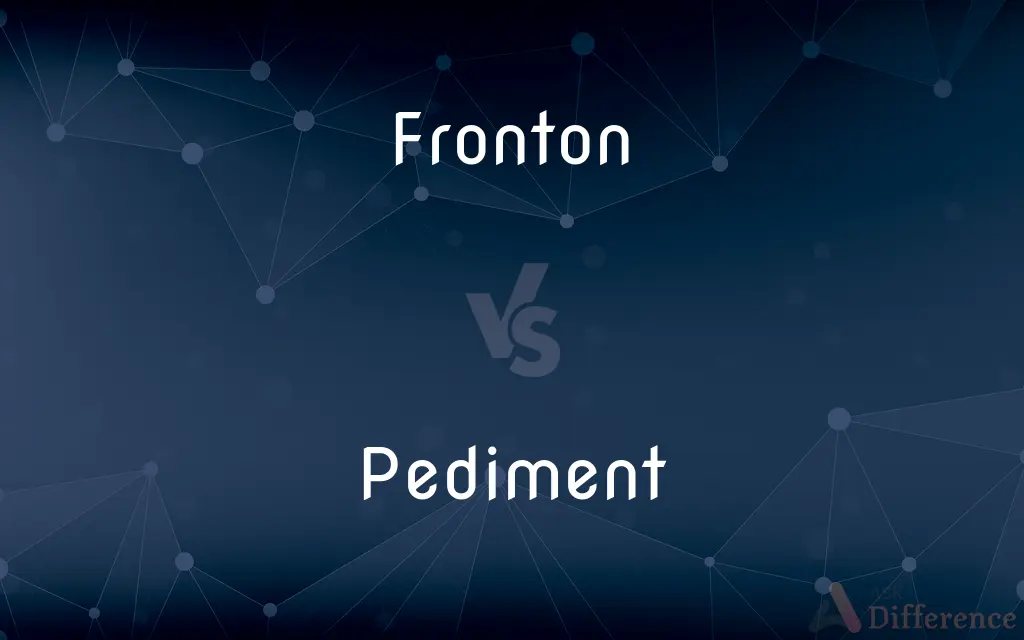Fronton vs. Pediment — What's the Difference?
By Urooj Arif & Maham Liaqat — Updated on March 31, 2024
Fronton, a term less commonly used in English, often refers to the facade of a pelota court, whereas a pediment is an architectural element found atop Greek temples, reflecting classical beauty.

Difference Between Fronton and Pediment
Table of Contents
ADVERTISEMENT
Key Differences
Fronton is a term with limited use outside specific contexts, primarily known in the world of Basque pelota as the front wall of the court where the ball is played. It's an essential part of the game, serving both as the playing surface and a defining feature of the court's architecture. On the other hand, a pediment is a widespread architectural feature that crowns the entrance of Greek temples, Renaissance buildings, and various structures, characterized by its triangular shape. This element is not only structural but also decorative, often filled with sculpture or other ornamentation to convey themes of significance and grandeur.
In terms of architecture, fronton's role is functional within the context of Basque pelota, providing a surface against which players strike the ball. It's a critical component of the game's play area, influencing the game's dynamics and strategies. Whereas, the pediment's role is both structural and decorative, adding to the aesthetic appeal and thematic richness of a building. It often depicts mythological scenes or historical events, contributing to the narrative element of architecture.
Frontons are specific to the cultural and sporting context of the Basque region and other areas where Basque pelota is played. Their design and construction are tailored to the requirements of the sport, with variations in size and material depending on the pelota variant. Pediments, however, are a universal architectural element found in many cultures worldwide, adapted over centuries to fit various architectural styles, from classical Greek to neoclassical and beyond.
While frontons are integral to the functionality of pelota courts, influencing the play through their dimensions and surface quality, pediments are primarily aesthetic and symbolic. The design and embellishments of a pediment can denote the building's purpose, the era of its construction, and its cultural significance.
The consideration of frontons and pediments highlights the diverse ways in which architecture and design serve human activities and values. Frontons exemplify the integration of architectural design with sports, creating spaces that facilitate and enhance physical games. Pediments, by contrast, reflect the human desire to imbue structures with meaning and beauty, elevating functional buildings into works of art that communicate ideals, celebrate achievements, and memorialize history.
ADVERTISEMENT
Comparison Chart
Definition
Front wall of a pelota court
Triangular upper part of the facade of a building
Primary Function
Serve as the main playing surface in Basque pelota
Architectural and decorative element
Context of Use
Basque pelota and similar games
Classical architecture, especially Greek and Roman temples
Cultural Significance
Central to the Basque pelota, a regional sport
Symbolizes classical beauty, often contains sculptures or motifs
Variations
Depends on the pelota variant, can vary in size and material
Varied styles in different architectural periods
Compare with Definitions
Fronton
A front wall in Basque pelota courts.
The player hit the ball against the fronton with precision.
Pediment
Symbolizes beauty and symmetry in architecture.
The architect designed the pediment to embody classical ideals.
Fronton
Reflects regional sports culture.
In the Basque Country, the fronton is a common sight in towns.
Pediment
Found in classical and neoclassical architecture.
The museum's neoclassical pediment added to its grandeur.
Fronton
An essential feature in pelota courts.
The new court's fronton was made from specially treated concrete.
Pediment
Often features decorative elements.
The pediment's relief depicts a historical battle.
Fronton
Varies based on the pelota game variant.
This fronton is higher, suiting the jai alai variant.
Pediment
A triangular upper part of a building's facade.
The temple's pediment was adorned with sculptures of the gods.
Fronton
Impacts the game's dynamics.
A smooth fronton surface ensures faster gameplay.
Pediment
Adaptable to various architectural styles.
Modern interpretations of the pediment blend tradition with innovation.
Fronton
An arena for jai alai.
Pediment
A pediment is an architectural element found particularly in Classical, Neoclassical and Baroque architecture, and its derivatives, consisting of a gable, usually of a triangular shape, placed above the horizontal structure of the lintel, or entablature, if supported by columns. The tympanum, the triangular area within the pediment, is often decorated with relief sculpture.
Fronton
(architecture) A pediment.
Pediment
The triangular upper part of the front of a classical building, typically surmounting a portico.
Fronton
A two-walled or single-walled court used as a playing area for Basque pelota.
Pediment
A broad, gently sloping expanse of rock debris extending outwards from the foot of a mountain slope, especially in a desert.
Fronton
Same as Frontal, 2.
Pediment
A wide, low-pitched gable surmounting the façade of a building in the Grecian style.
Pediment
A triangular element, similar to or derivative of a Grecian pediment, used widely in architecture and decoration.
Pediment
(Geology) A broad, gently sloping rock surface at the base of a steeper slope, often covered with alluvium, formed primarily by erosion.
Pediment
(architectural element) A classical architectural element consisting of a triangular section or gable found above the horizontal superstructure (entablature) which lies immediately upon the columns; fronton.
Pediment
Originally, in classical architecture, the triangular space forming the gable of a simple roof; hence, a similar form used as a decoration over porticoes, doors, windows, etc.; also, a rounded or broken frontal having a similar position and use. See Temple.
Pediment
A triangular gable between a horizontal entablature and a sloping roof
Common Curiosities
What is a pediment?
A pediment is the triangular upper part of a building's facade, often decorative.
How does a fronton function in Basque pelota?
It serves as the main playing surface against which players strike the ball.
Are frontons found in sports other than Basque pelota?
Primarily, frontons are associated with Basque pelota and its variants.
Can pediments be found on modern buildings?
Yes, modern buildings sometimes incorporate pediments in their design, often in a stylized form.
What materials are used to construct a fronton?
Frontons can be made from concrete, wood, or other materials suitable for impact.
What is a fronton?
A fronton is the front wall of a pelota court, crucial for the game.
What architectural styles feature pediments?
Classical, Renaissance, and neoclassical styles commonly feature pediments.
What themes are commonly depicted on pediments?
Mythological scenes, historical events, and symbolic motifs are common.
Can the design of a fronton affect the gameplay of Basque pelota?
Yes, the surface quality and dimensions of a fronton can significantly impact gameplay dynamics.
How does the pediment contribute to a building's aesthetics?
It adds symmetry, beauty, and thematic depth to the building's facade.
Why are pediments significant in classical architecture?
They symbolize the ideals of symmetry, beauty, and balance, central to classical architectural philosophy.
Is the design of a fronton standardized?
The design can vary, but it must meet the specific requirements of the pelota game being played.
Are there different types of pediments?
Yes, including broken, segmented, and open pediments, each offering a distinct look.
How does the function of a pediment differ from its aesthetic role?
While initially structural, its primary role in contemporary architecture is decorative.
What is the cultural significance of a fronton in the Basque region?
It's a central feature in Basque pelota, reflecting the region's sports culture.
Share Your Discovery

Previous Comparison
Certificate vs. Transcript
Next Comparison
Showcase vs. PresentationAuthor Spotlight
Written by
Urooj ArifUrooj is a skilled content writer at Ask Difference, known for her exceptional ability to simplify complex topics into engaging and informative content. With a passion for research and a flair for clear, concise writing, she consistently delivers articles that resonate with our diverse audience.
Co-written by
Maham Liaqat













































